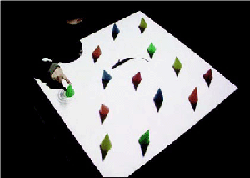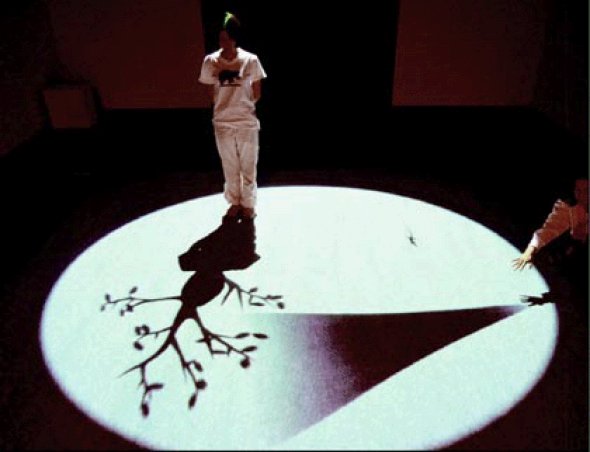minim++ at Lovebytes
Do festivals of digital art seem like the kind of places trainspotters might go to die, or where post-graduate librarians develop more and more complex and irritating questionnaires on how we rate art we’ve just encountered? Festivals of digital art reflect and encourage a simplistic and one-dimensional fixation with the complicatedness of technology as opposed to the straightforwardness of making stuff. Do you a) strongly agree, b) don’t know, or c) strongly disagree?
Now almost 10 years old, Lovebytes is a digital arts festival that should positively influence your decision. Having played a small part in this and past years’ festivals (by organising the performance programme), I speak from relatively intimate experience. Based in Sheffield, Lovebytes brings together performance, installation, artist led workshops, screenings and panel debates and has been responsible for bringing new international artists to the UK, and commissioning many groundbreaking works. In doing so, it has established a reputation for responding intelligently to the difficult issues raised by contemporary digital arts practices.
A highlight of this year’s festival was the first major international exhibition by the Japanese group minim++, who showed a collection of new and recent works suggesting alternatives to screen-based interactivity – a move beyond the mouse-screen, hand-eye paradigm. They centre on spatial and tactile systems, and generally involve and encourage movement and touch. However, minim++ understand that speaking about interaction in terms of systems is missing the point: in fact, their work goes to great lengths to demonstrate the difference between interface and interaction, demanding new phenomenological typologies through a subtle interruption of normalised experience.
 In one piece, a series of coloured cones are arranged upon a white surface, each of which casts a shadow. However, when one touches a cone its shadow (which turns out to be a video projection) starts to move, change colour, wiggle, shoot off the edge of the table, and so on. In a similar piece, several household objects – scissors, teapots, cups – are fixed to a wooden table. Again they cast shadows, but this time each is augmented with a projected one. When an object is touched, something is added to its shadow – ants run out of a sugar bowl, a moth flies from a tea strainer, eyes appear in the scissors.
In one piece, a series of coloured cones are arranged upon a white surface, each of which casts a shadow. However, when one touches a cone its shadow (which turns out to be a video projection) starts to move, change colour, wiggle, shoot off the edge of the table, and so on. In a similar piece, several household objects – scissors, teapots, cups – are fixed to a wooden table. Again they cast shadows, but this time each is augmented with a projected one. When an object is touched, something is added to its shadow – ants run out of a sugar bowl, a moth flies from a tea strainer, eyes appear in the scissors.
In other works images are projected onto the floor, and movement within the space forms a means of interaction. One invites viewers to move through a beam of light, only to make a series of shadows extend from their own so that trees grow out of bodies, and lizards emerge from feet. Despite the works’ apparent similarity, one’s sense of place inside each is radically different: occupying a free-floating point in space is very different from pondering the surface of an object.
minim++’s work emphasises different kinds of understanding; the relationship of our bodies to the environment, and the sense of agency and control we derive from encounters with objects, interfaces and spaces. They aim to disturb the illusions inherent in simple instances of human-computer interaction, whose overriding fixation is with usability, predictability, familiarity, transparency, and so on. Yet minim++’s aim is not simply to confuse us with lots of random or unexplainable events, but rather to subtly play upon our sense of the familiar. In this, their work not only fits into a long tradition of artists exploring embodied interaction, but also with the emerging concerns of ‘decentred’ interaction. Such explorations take us beyond the notion of the artwork as interactive toy into a more complex and densely populated conceptual territory. They show us there are many other ways of engaging with interactive art than being absorbed in an effortless activity. Some of these involve mere observation of another’s actions, others contemplation, reflection and considered action.
Lovebytes’ weekend debates often dealt with the relationship between art and technology. They made clear that digital art identifies itself as having a special kind of relationship with a special kind of technology and, to some extent, mirrored classically avant-garde approaches to the subject. Then again, they also showed these approaches to be essentially and radically different. Whereas the avant-garde sought to question the notion of technology as an instrument, or a means to an end, many of the artists exhibiting and speaking at Lovebytes attempted to turn the art itself into the instrument. Such artists enable us to think of technology not just as objects, tools, or even practices, but instead as a set of beliefs about what goes on between the beginning and end of creative processes. They highlight how artists not only make things, but more importantly, make ways of making things.
Lovebytes International Festival of Digital Art 2003 // Sheffield // 15 February – 22 March
Lovebytes [http://www.lovebytes.org.uk]
Mute Books Orders
For Mute Books distribution contact Anagram Books
contact@anagrambooks.com
For online purchases visit anagrambooks.com








